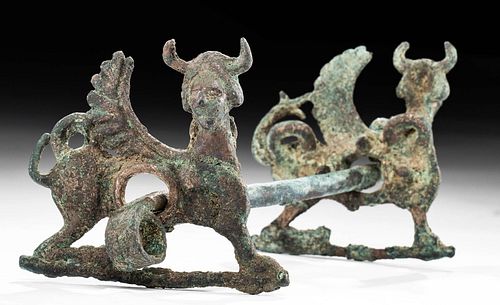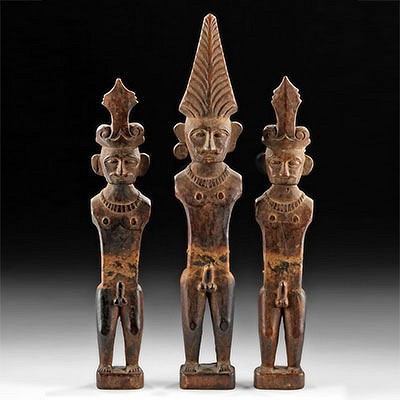Luristan Bronze Cheek Pieces and Bit - Winged Bull Men
Lot 52
About Seller
Artemis Gallery
686 S Taylor Ave, Ste 106
Louisville, CO 80027
United States
Selling antiquities, ancient and ethnographic art online since 1993, Artemis Gallery specializes in Classical Antiquities (Egyptian, Greek, Roman, Near Eastern), Asian, Pre-Columbian, African / Tribal / Oceanographic art. Our extensive inventory includes pottery, stone, metal, wood, glass and textil...Read more
Categories
Estimate:
$2,200 - $3,300
Absentee vs Live bid
Two ways to bid:
- Leave a max absentee bid and the platform will bid on your behalf up to your maximum bid during the live auction.
- Bid live during the auction and your bids will be submitted real-time to the auctioneer.
Bid Increments
| Price | Bid Increment |
|---|---|
| $0 | $25 |
| $300 | $50 |
| $1,000 | $100 |
| $2,000 | $250 |
| $5,000 | $500 |
| $10,000 | $1,000 |
| $20,000 | $2,500 |
| $50,000 | $5,000 |
| $100,000 | $10,000 |
| $200,000 | $20,000 |
About Auction
By Artemis Gallery
Jun 25, 2020
Set Reminder
2020-06-25 10:00:00
2020-06-25 10:00:00
America/New_York
Bidsquare
Bidsquare : CLEARANCE - Ancient, Pre-Columbian, Ethno Art
https://www.bidsquare.com/auctions/artemis-gallery/clearance---ancient-pre-columbian-ethno-art-5264
Featuring discounted pricing on antiquities from Egypt, Greece, Italy, and the Near East...plus Viking, Asian, Pre-Columbian, Tribal, Russian Icons, Spanish Colonial, Fine Art, more! Starting prices have been reduced up to 65% from original auction prices - perfect for dealers and collectors. Artemis Gallery info@artemisgallery.com
Featuring discounted pricing on antiquities from Egypt, Greece, Italy, and the Near East...plus Viking, Asian, Pre-Columbian, Tribal, Russian Icons, Spanish Colonial, Fine Art, more! Starting prices have been reduced up to 65% from original auction prices - perfect for dealers and collectors. Artemis Gallery info@artemisgallery.com
- Lot Description
**Originally Listed At $1200**
Ancient Near East, northwestern Iran, Luristan, ca. 1000 to 600 BCE. A very interesting piece, a horse bit with matching cheekpieces that has been cast by the lost wax technique into the shape of two dramatic, solid zoomorphic figures that are winged bulls with human faces - often a symbol of royal protection in this region. They are joined along an axis of a narrow bronze cuboid. Two curved ends rise from the central axis, which the cheekpieces are fitted over through a large open ring in each of their centers. The piece is comprised of three parts, displayed as it would have been in use. Ancient Luristan, a region of mountains and plains, is renowned for its highly advanced bronze work, much of which was buried as grave goods. Size: 7.5" W x 3.6" H (19 cm x 9.1 cm)
The affluent group in Luristan society that patronized the metalworking industry and purchased decorative items like these were nomadic horsemen. They would travel into towns and purchase bronze and iron objects from craftsmen there. Although these horsemen were pre-literate, we know from the records of the Elamites and other southern neighbors that they were mercenaries in the constant warfare between the Sumerians, Babylonians, Assyrians, and Elamites. Their horses were their livelihood, and they seem to have ornamented them as beautifully as they ornamented themselves.
Provenance: private Orange County, California, USA collection, acquired before 2000
All items legal to buy/sell under U.S. Statute covering cultural patrimony Code 2600, CHAPTER 14, and are guaranteed to be as described or your money back.
A Certificate of Authenticity will accompany all winning bids.
We ship worldwide and handle all shipping in-house for your convenience.
#153678Excellent preservation of form, although the two cheekpieces are slightly bent. Beautiful mottled green patina with hints of blue and copper.Condition
- Shipping Info
-
All shipping is handled in-house for your convenience. Your invoice from Artemis Gallery will include shipping calculation instructions. If in doubt, please inquire BEFORE bidding for estimated shipping costs for individual items.
-
- Buyer's Premium



 EUR
EUR CAD
CAD AUD
AUD GBP
GBP MXN
MXN HKD
HKD CNY
CNY MYR
MYR SEK
SEK SGD
SGD CHF
CHF THB
THB














